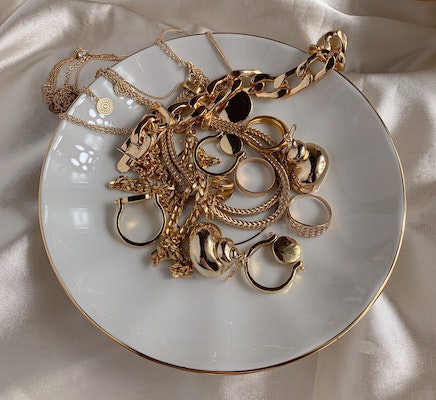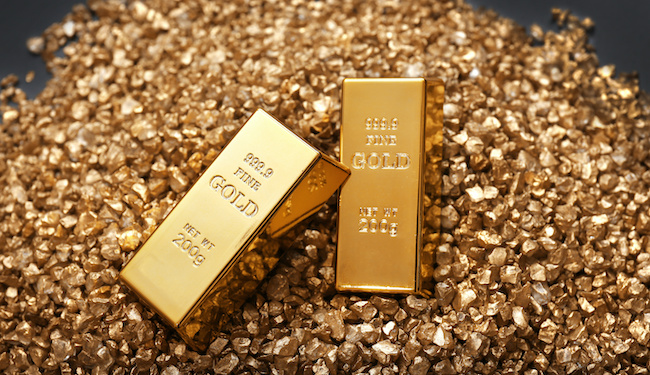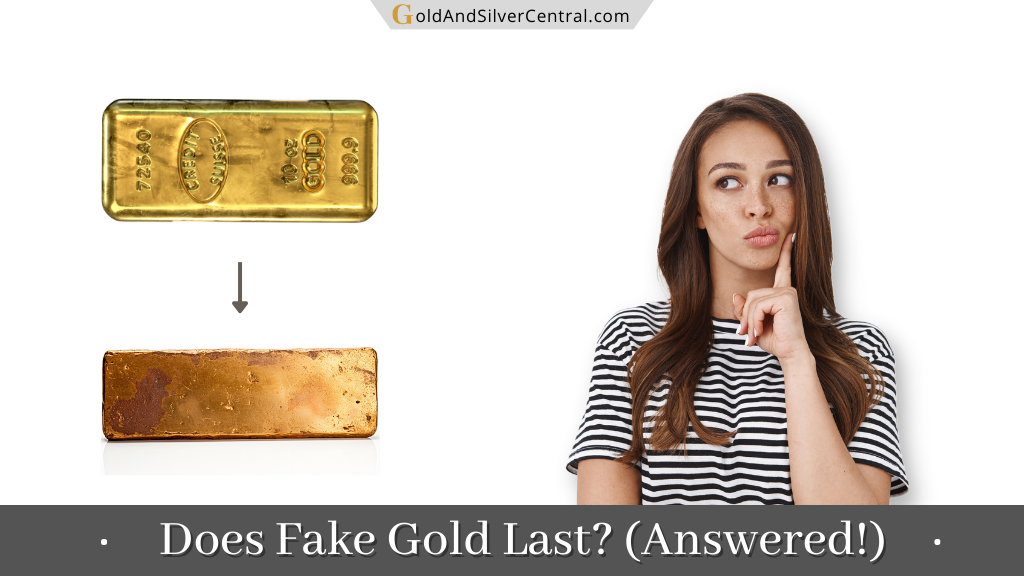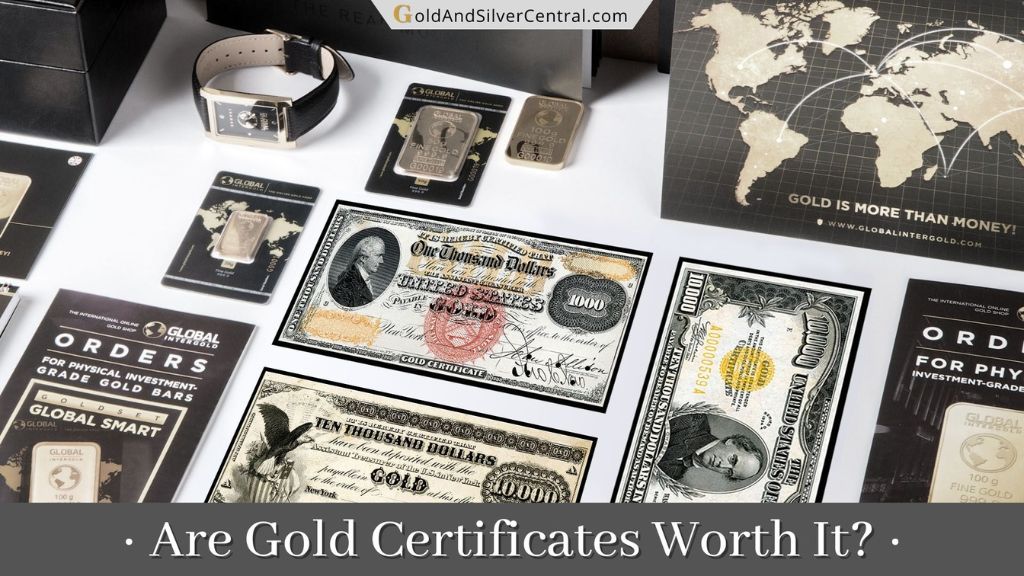So:
Does counterfeit gold stand the test of time? How to spot fake gold? It’s a hot topic, especially if you’re considering to invest in this yellow metal.
Now, it’s got plenty of aliases—gold-plated, gold-filled, or gold-coated, to name a few.
It looks like the real deal on the surface, but in reality it’s missing that precious, shiny content that we all love.
Today, we’ll find out what fake gold is made of, how it manages to play dress-up for so long, and what kind of risks we’re taking if we end up with this faux bling.
You’ll learn how to tell if gold is real, and knowing how durable and long-lasting it is can be is crucial in avoiding dodgy scams.
Without further ado, let’s get started.
The Composition of Counterfeit Gold
Let’s face it:
Fake gold is basically a masquerade party. It’s all about using materials that look like real gold but don’t share its fantastic properties and value.
Let’s take a closer look at what makes up counterfeit gold and how it stacks up against the real deal.
Base Metals and Alloys
Counterfeit gold loves to use base metals and alloys as its backbone. We’re talking about copper, zinc, nickel, brass, or other cheap metals.
These materials are the unsung heroes of the fake gold world, giving it its structure and stability.
Gold Plating or Coating
To fool the eye, counterfeit products get decked out with a thin layer of gold, either through plating or coating.
The catch is the actual precious metal used is just a fraction compared to the total weight of the item.
This process slaps a thin layer of real gold to the base metal’s surface, making it look like it’s a solid one.
Lack of Genuine Gold Content
That’s the big giveaway that separates fake and authentic gold.
Fake products have little to no gold, making them a far cry from genuine items with high gold purity.
This missing important content affects the durability, value, and other physical characteristics that make real gold, well, gold.
Types of Counterfeit Gold
Fake gold sneaks around in several disguises, each crafted to trick unsuspecting folks into believing it is the real deal.

Knowing these counterfeit culprits is a must to spot any fakes that cross our path.
Let’s look at the usual suspects:
Gold-Plated
These are the things that are basically just base metal slathered with a slim layer of gold.
At first glance, they can seem like they’re solid, thanks to that golden outer shell.
But the core material usually isn’t worth a dime. Over time, that shiny layer will likely start wearing off, showing the cheap base metal hiding underneath.
Gold-Filled
They are like their gold-plated cousins but have a thicker layer of gold hugging the base metal core. It gets bonded to the base metal through some mechanical or heat process.
Even though gold-filled items have more of the precious metal than gold-plated items, the base metal inside still isn’t worth much.
The upside, though? That thicker layer tends to last longer and hold up better than gold-plated products.
Gold-Coated
These are like gold-plated items on a diet — they’re covered in an even thinner layer of gold.
They can’t withstand wear and tear because the gold coating rubs off easily, revealing the base metal underneath pretty much right away.
Remember, all these types of counterfeit gold don’t have the same qualities that make genuine metal so valuable.
They don’t share the same durability, resistance to tarnishing, or investment value that comes with the real deal.
Spotting fake gold can be tricky since they can look pretty much like the real thing.
That’s why we need to rely on more than our eyes — additional testing and inspection methods are key to ensuring our gold is legit.
Durability and Wearability
Because it’s missing genuine gold’s magic touch, fake products often behave differently and may not go the distance like the real deal.

For example, you may have these questions:
- Does fake gold wear off?
- Does all fake gold rust or turn green?
Let’s have a deeper look into it.
Tarnishing and Discoloration
Fake gold items have a bad habit of tarnishing and changing color over time.
The base metal used don’t share the superstar properties of the real yellow metal, which means they can react with things in the environment and start to tarnish or change color.
Therefore, these products can lose sparkle, look dull or be discolored as the gold plating or coating wears thin or reacts with the base metal underneath.
For example, you may have noticed that when wearing fake gold bracelets, rings, or necklaces, your skin can turn green, blue, or black.
This is because the acidic skin or the chemicals in your sweat react with the fake content of your jewelry, transferring the green tint to your skin.
Wear and Abrasion
Faux bling products are also more sensitive to wear and abrasion.
That thin layer of gold plating or coating can scratch or wear off easily, showing the world what’s really underneath.
With regular use or exposure to friction, these items can show wear signs like the yellow color fading or patches where the base metal peeks through.
Lack of Longevity
Real gold is known for its incredible durability, resistance to corrosion, and ability to look good over time.
But the fake one?
It doesn’t have these qualities. This means it might deteriorate faster, lose its shine, or become damaged more easily.
How to Test and Detect Fake Gold
Spotting counterfeit gold is a nifty skill that gives you the power to tell the real from the phony.
There are many testing and detection methods out there that can help confirm whether a gold product is the real deal.
Let’s go through some of those.
Visual Inspection
Start with a simple visual inspection.
Real gold has some standout features like a lush, even color and a smooth, shiny surface.
Fake ones might show hints of discoloration, uneven coloring, or flaws that don’t match what real metal looks like.
But remember, looks can be deceiving, so don’t rely solely on your eyes to confirm authenticity.
Proving Its Purity through Acid Testing
Acid testing is a go-to method for checking gold purity.
It works by putting some acid solution on the product and watching the reaction.
Real gold doesn’t react to some acid solutions, but the base metals used in fake products might react, showing discoloration or bubbling.
You can get acid testing kits with different acid concentrations for more spot-on results.
Electronic Testing
This type of testing uses gadgets, like electronic testers, to use conductivity measurements to check purity of precious metals.
These pocket-friendly devices offer quick and damage-free testing by zapping an electric current through the product.
That way it gauges the resistance to the electric current and estimates the purity of the metal.
Keep in mind though that these electronic testers have limits and need the right calibration and a knowledgeable operator.
Expert Eyes
A professional appraisal from a seasoned jeweler or appraiser is another reliable way to check if the gold products are authentic.
These pros have the know-how and special tools to accurately check metal’s purity, weight, and value.
They might use a mix of visual inspection, acid testing, and other advanced tricks to give a professional opinion on the item’s authenticity.
Ultraviolet (UV) Light Testing
This is about checking out the glow of gold under UV light.
Real gold typically shows little glow, while certain base metals like copper, zinc, and nickel might glow differently.
UV light testing can offer some extra insights and help spot fake gold.
Just a heads up — using a mix of these testing methods will give you more accurate results.
Sometimes we need to call in the big guns and use fancy methods, like specific gravity testers or X-ray fluorescence (XRF) alloy analyzers.

When it comes to testing, it’s worth investing in reputable products or getting advice from the pros.
Remember, experts, labs, and appraisers do this kind of thing for a living.
They have all the gear and know-how to tell us whether our gold is the real deal or a dud, so there is no need to do it yourself if you don’t want to.
How to Protect Yourself from Scams
This guide won’t be complete without talking about how to keep yourself safe from fraudulent dealers.
By keeping your eyes wide open and taking some smart steps, you can dodge any scams.
Here’s how you can do it:
Always Go with Trustworthy Sellers
You should always get your precious metals from sellers with a solid rep for selling the real deal. This could be well-known reputable companies, jewelry stores, or bullion dealers.
Look for great reviews, certifications, and industry ties to make sure they are legit.
For example, for cash purchases or investing in a Gold IRA, Augusta Precious Metals is our go-to company, and they have an absolutely stellar reputation.
Verify Certifications and Hallmarks
Gold products usually have certifications or hallmarks that give us the thumbs up that they’re authentic. These are like the metal’s ID card telling us about its purity and quality.
There’s usually a stamp or engraving that can confirm this. Make sure you know what hallmarks you should look for in a region or country.
Conduct Visual Inspections
Don’t underestimate the power of your eyes. Give that shiny piece a good look over.
Check for anything weird, like a color that’s a bit off, shoddy work, or any signs it’s seen better days. Real gold is all about quality and should look the part.
Use Professional Appraisals
It never hurts to get a second opinion, especially from someone who knows their stuff.
Professional jewelers or appraisers have the skills and tools to check if that gold’s real. They can do all sorts of tests and give you a solid opinion.
Do Additional Testing
You could also consider taking more steps, like acid tests or electronic testing kits. They can give you a pretty good idea of your situation.
Remember, it’s best to know what you’re doing or get some guidance so you don’t accidentally wreck anything.
Educate Yourself
Keeping up-to-date with what’s happening in the counterfeit gold world is also a good move.
The more you know about common scams, how to spot fake gold, and what’s happening in the precious metals market, the better you’ll be at sniffing out anything that doesn’t quite smell right.
Knowledge is power; remember that!
Trust Your Instincts
Got a weird feeling about a deal? Something seems off?
Trust what your gut says.
Be careful if prices seem crazy low or if you feel like you’re being pressured into a sale. Be wary of sellers who aren’t upfront or can’t give you proper paperwork.
Maintain Documentation
Don’t toss out your paperwork.
Keep your invoices, certificates, and other documents related to your precious metal purchases. They’re proof of authenticity and can help if any issues pop up later.
Report Counterfeit Incidents
If you’ve been scammed or you think something sketchy is going on, don’t stay silent. Report it to the right people.
By speaking out, you’re helping stop these scams and protecting others from falling for the same tricks. Remember, we’re all in this together!
Say No to Fake Gold
Counterfeit ones just don’t have the same properties as the real deal. It might look good, but it can’t match genuine metal’s longevity and durability.

Watch out for stuff like tarnishing, color changes, and wear and tear that can happen faster with the fake stuff.
Knowing all these risks is crucial. When you’re well-informed, you can dodge the pitfalls and only spend your hard-earned cash on actual investments.
Don’t forget, making sure your gold is the real deal should always be the name of the game when you’re buying.
Do your homework on where you’re buying from, check for authenticity marks, and consider getting an expert opinion to be extra sure.
Being proactive can save you from financial headaches, legal troubles, and the emotional roller coaster that comes with counterfeit products.
After all, we all want to fully enjoy the perks and value that only genuine gold can offer.
Now:
Buy authentic coins and bars for physical ownership or in your IRA through our #1 recommended Gold IRA company in the US, Augusta Precious Metals.
They’re committed to making sure that every piece of product sold on their platform is highly pure.
So pure that they are IRS-approved for your retirement account. Plus, they’re all about education, offering it for free so you can confidently walk the gold IRA path.
If this sounds interesting to you, call the Augusta team at 833-989-1952 to learn more.
You can also grab their guide here and get a FREE GOLD coin when you open an account with them.

Now, we’d like to hear from you.
If you’ve dealt with the issues we talked about today, please share:
- How long does fake gold last, in your experience?
- What are your best tips on how to spot fake gold?
Let us know your experience in the comments below!






